5 STARS OUT OF 5 (Want to know what exactly our star ratings mean? Check out our explanations here)
Shakespeare’s A Midsummer Night’s Dream is one of my favorite plays. It stands to reason that Balanchine’s A Midsummer Night’s Dream is one of my favorite ballets of all time—though for different reasons. Both are funny, both are beautiful, but I adore Shakespeare’s for its wordplay and absurdity, its complication and humor. Balanchine’s adaptation is simplified and, obviously, has no wordplay. It’s still funny, and plenty absurd, but there is also a certain intensity to the story in his version. The whole story is told swiftly, (perhaps adding to the complication) and the dancing is superb, as well as being very difficult. I regard Balanchine’s Midsummer as a masterpiece. I can remember watching the 80’s PBS broadcast of New York City Ballet’s production on a loop from an old VHS tape. Set to music by Felix Mendelssohn, it is one of the precious few full-length story ballets Balanchine created, the others being his Coppelia, Harlequinade, and, of course, The Nutcracker.
A plot summary will be difficult, so bear with me. If you know the story you can probably skip this paragraph. Here are the characters. Outside of the human world, the Fairy King Oberon and Queen Titania are having a fight over a changeling boy. Oberon wants the human child to be his assistant/page/knight, while Titania wants to keep him for herself (in the play its because his mother worshipped Titania—in the ballet it isn’t really explained). Butterfly is a—you guessed it—butterfly and Puck is a mischievous sprite, both under the command of Oberon. Titania has her personal handmaidens and a cavalier. Titania also has the aforementioned child. You keeping up? I hope so, because there’s more. There are four Athenian human lovers: Lysander and Hermia (helpfully color-coordinated, wearing blue), and Demetrius and Helena (wearing red). Lysander and Hermia are in love. Helena loves Demetrius but he loves Hermia. If you’re confused, I understand, but there’s more. There’s a crew of artisans, including the poor Nick Bottom who is, eventually, given the head of a donkey—Puck “makes an ass” of him. Finally, we have Theseus, the hero-king of Athens and the Amazon Queen Hippolyta.
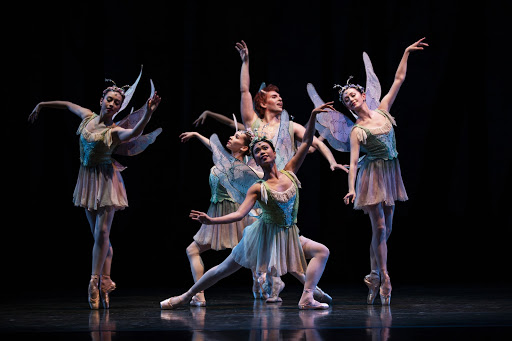
The scene opens on a number of young students from the PNB School as bugs buzzing around the stage in tight formations. Balanchine uses the overture to introduce all of the characters.
Angelica Generosa’s energetic, bright Butterfly and Johnathan Poretta’s cartoonish Puck are both A+ casting and performances. This is principal dancer Poretta’s first dancing role since a severe Achilles tendon injury in January 2018, and he’s retiring at the end of this year. As far as a first role, Puck is an intense one, but Poretta brings every ounce of his signature abandon.
We see a weeping Helena, danced by Lindsi Dec, wandering through the forest; she is in love with Demetrius, but… The fairies notice her, and the bugs even appear to try and comfort her, but Helena cannot see them. Kyle Davis is an athletic, frustrated Oberon, upset with the long-lined Laura Tisserand’s Titania. Next we meet Lysander, danced by Benjamin Griffiths, Hermia played by soon-retiring Rachel Foster, and William Lin-Yee’s Demetrius, bowing before Dylan Wald’s Theseus.
Whoo, that was a long couple of paragraphs. Now we can get into the dancing.
Titania and her cavalier have a luscious pas de deux in her…I guess bedchamber? It has a gorgeous set of flowers and the famous shell throne taking center stage. https://youtu.be/1UeyRifpO8A (note: this video is old, and there are new sets and a gorgeous handpainted silk costume for Titania). Titania’s retinue of corps dancers are lovely, and Laura Tisserand’s exquisite lines are nothing short of perfect. Titania’s cavalier (danced by Joshua Grant) is mostly just present as a crane to lift Titania around, but Tisserand’s glossy extensions and easy balances are fascinating to watch. This is one of the long-limbed, lyrical roles that seem as though they were made for her, breezing through the penchés and developés with grace. Puck interrupts in an attempt to steal away the child for Oberon, but is caught and sent away by the fairies.
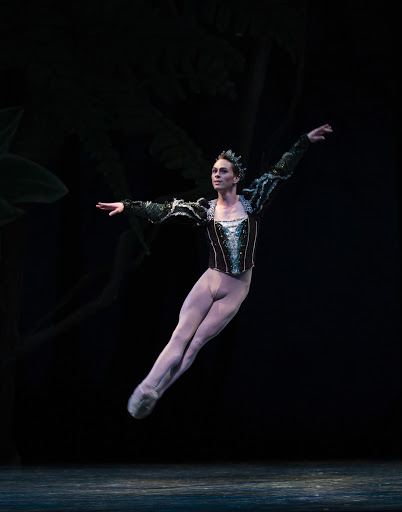
Next, Oberon and Butterfly effortlessly execute the nastily difficult scherzo portion of the music. Oberon was created on Balanchine’s powerhouse principal Edward Villella, and like most of Villella’s roles, Oberon requires extreme athleticism and speed. Kyle Davis is strong, musical, swift and light, threading between the gigantic corps of bugs. Angelica Generosa’s pitch-perfect technique and sense of balance is startling. They both flash through the air, zip through turns and extend balances with precision and glee.
Oberon sends Puck after a magic flower, which will make someone fall asleep and fall in love with the first thing they see when they wake up. Lysander and Hermia happily dance through the forest together, stealing kisses in the moonlight. In contrast, Demetrius and Helena are fighting and bickering. Helena is throwing herself upon Demetrius, desperate for him to return her love; Demetrius is frustrated with her advances, and, in a not-so-self-aware move, is pursuing Hermia.
Puck, seeing the poor Helena, decides to fix the conflict. But, whoops! He enchants Lysander by mistake, and now Lysander is deeply infatuated with Helena. Helena is not interested—she wants Demetrius. Hermia walks in on Lysander trying to woo Helena; cue distracted boyfriend meme.
As Lysander puts it in the play, “The course of true love never did run smooth.” Now neither of the couples are together. Puck then decides to enchant Demetrius to fall in love with Helena– he finally reciprocates her advances. Now the ‘red couple’ is together, and the ‘blue couple’ has been torn apart.
Back in Fairyland, Titania has a solo to my favorite music performed in the ballet: Mendelssohn’s “Ye Spotted Snakes”. Here’s a recording of Patricia Barker dancing Titania from the BBC recording: https://youtu.be/C8xrpvOhYRE.
Laura Tisserand is nothing short of titanic (get it? No, not like the boat). Her jumps are astonishing, her arabesques deep and rich, her loose hair whirling around her like expensive fabric, and her expression with her arms and head is truly beautiful and smooth as liquid.
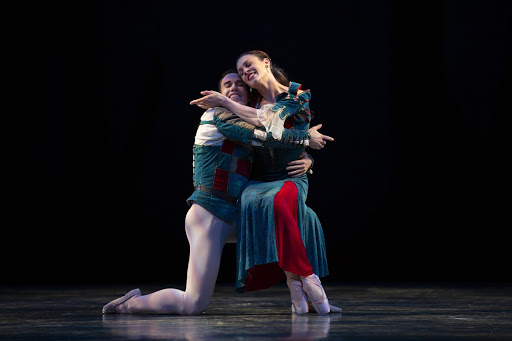
After Titania falls asleep, we watch the very beautiful Rachel Foster dance the sad Hermia solo. It strikes me here, in her turns, how gorgeous Martin Pakledinqz’s costumes really are. The skirts have that wonderful flowing, layered quality with their dual color palette.
Puck beats the crap out of (or at least as much as possible for someone who isn’t completely tangible to humans) a group of men and grabs one: Bottom (Ezra Thompson). Puck gives Bottom, quote, ‘the head of an ass’, unquote, and drags him to Titania’s bedside.
Oberon uses the flower on her, and boom, she’s in love with an ass. Hilarity and bad puns ensue.

The pas de deux between Titania and Bottom is kind of endearing, not to mention funny.
Then we get a fun surprise, in the form of Elle Macy dancing the role of Hippolyta. The Amazonian Queen wearing gold and wielding a bow leaps and turns furiously through the forest with her hunting hounds. Macy was as golden as her character, and at least as awe-inspiring, moving at a blistering speed and jumping to astonishing heights. Meanwhile, the Athenians are fighting each other and Puck is having the time of his life antagonizing them. Finally, Oberon and Puck put the couples all asleep and fix Puck’s mistake with Lysander. Both couples are now whole!
Oberon then disenchants Titania, who is sleeping peacefully next to her beloved Bottom. After she is horrified to Oberon’s satisfaction, Puck gives Bottom his head back and the fairies make peace. Back in the human world, Theseus proposes to Hippolyta and the mortals begin planning their triple wedding.
ACT 1 END.
Thankfully for this article, Act 2 is completely storiless–it’s just the wedding itself. It’s pretty much just dancing. Very familiar to listeners is Mendelssohn’s Wedding March, which is that iconic piece of music that plays at every single wedding reception ever oh my god find something else you might recognize from modern weddings.
The huge corps of dancers are wearing the same blues and reds as the humans in act one, though in much shorter tutus and partnered together. The women outnumber the men two-to-one, which allows for wonderful formation changes and lines across the stage. Lysander with Hermia and Helena with Demetrius are joined by Hippolyta and Theseus for a short time, until my favorite part of the whole ballet: the divertissement. Instead of the play-within-a-play Pyramus and Thisbe from Shakespeare’s Midsummer, Balanchine instead has a short, plotless ballet without the frills of narrative–as many of Balanchine’s ballets are. Led by two principals, Lesley Rausch and Jerome Tisserand, the 7-couple/14-dancer cast shifts, weaves, and spins to Mendelssohn’s 9th Symphony. The 6 ‘corps’ couples must be on their game, syncopated, dancing in rapid canon, completing complex maneuvers together.
SIDE NOTE: Balanchine famously let the corps dance; one of the landmark changes in ballet was the increased complexity of corps choreography by Marius Petipa–an example that comes to mind is Petipa’s recently reconstructed Valse Champetre dance from the St. Petersburg premiere in 1895 of Swan Lake. Balanchine expanded upon that greatly, crafting dances with corps dancers performing at the same level as the principals. They don’t simply stand on the sides and watch, they’re performing hard steps and dancing full out.
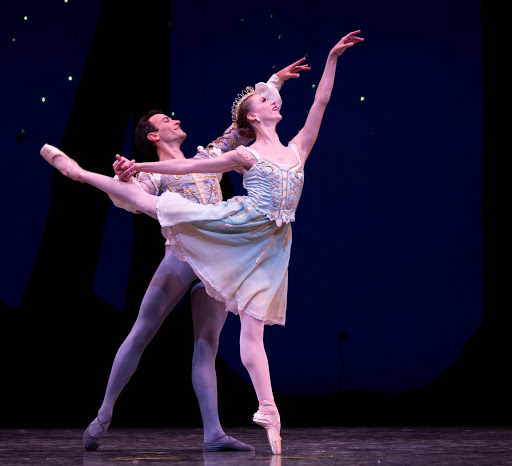
That said, Principal Lesley Rausch is absolutely incredible here and outshines the rest. Her unnamed character requires excellent lines, balance, and expression, not unlike Titania’s. However, unlike Titania, her pas de deux is with a partner of equal importance, rather than the Fairy Queen’s cavalier. The “Divertissement Pas de Deux” is often considered a representation of the ‘ideal love’ not found anywhere else in the ballet. The dancers are simply that: dancers. They aren’t simply dancing without a story, their dancing exceeds the confines of story. The conflicts between the many partners in Midsummer (the stylistic difference between Titania and Oberon, the political necessity of Theseus and Hippolyta’s marriage, the magic flower holding Demetrius and Helena together), in terms of their pas de deux, weaken their purity of relationship. In the divertissement, the characters have a pure love impossible in real life or in fiction. In the words of dance writer Anita Finkel, “They are dancers, and for Balanchine that is a state of being above both the human and the divine.”
I mean no offense to Jerome Tisserand in saying this, but I barely noticed him the whole duet. It is a testament to his partnering skills how wonderful Rausch could be. She has a quiet, reverent tone to her dancing and I couldn’t take my eyes off her. Tisserand’s partnering skills are at their best, elevating Rausch to impossible heights. There are no gymnastic feats, no great leaps, not an overhead press to be found. Instead Balanchine built a deeply personal, almost religious dance that is as mesmerizing as it it moving. I could watch it all day. It’s like a cool breeze on a hot night, with the stars and the moon peeking through from the backstage scrim and illuminating the couple in their suspended-in-liquid movements.
The coda of the divertissement is sweet and triumphant, even thrilling in its swift use of complex, kaleidoscopic organization of the dancers. The trilling music is perfectly suited to the pirouettes and sautés.
Finally, the characters from the story come back in a final celebration of their wedding. Back in Fairyland, Oberon and Titania have reconciled and leave Puck to sweep up the mess of the party—and, metaphorically, the mess he made of the human world with the flower. The closing image of Poretta, ascending up into the sky with the fireflies flashing and the butterflies (uh, buttering?) around him beautiful and sweet. The mess has been cleaned and all has been resolved.
Balanchine’s A Midsummer Night’s Dream runs for five more shows through April 21st at McCaw Hall.
Thu, Apr. 18 at 7:30 pm Fri, Apr. 19 at 7:30 pm, Sat, Apr. 20 at 2:00 pm, Sat, Apr. 20 at 7:30 pm, and Sun, Apr. 21 at 1:00 pm.





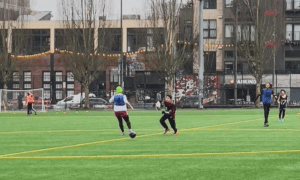

Be First to Comment